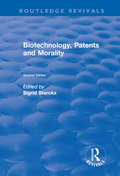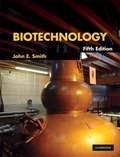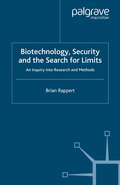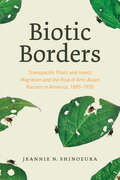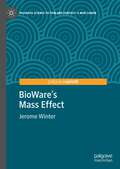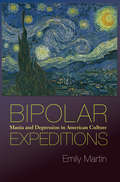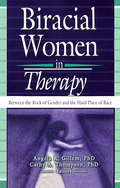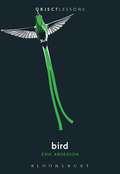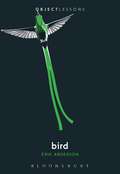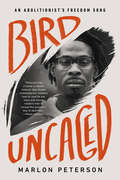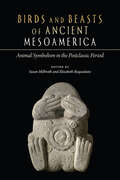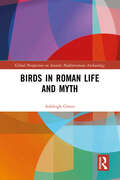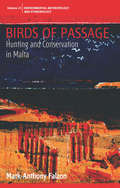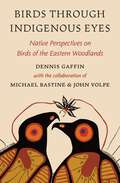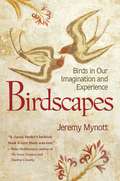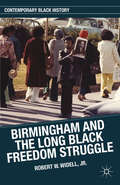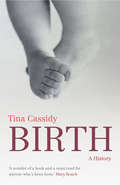- Table View
- List View
Biotechnology, Patents and Morality (Routledge Revivals)
by Sigrid SterckxThis title was first published in 2000. This work documents an international and interdisciplinary workshop on the ethical aspects of the patenting of biotechnological inventions, including genes, plants and animals. The public perception is discussed, along with how these perceptions relate to ethical, social and cultural factors. The legal framework in Europe is laid out by several experts in the field of patent law and the situation in the US is also briefly described. This edition also includes a general discussion of three important theories called upon to justify the patent system: the natural rights argument; the distributive justice argument; and the utilitarian argument. The chapter about the European Directive on the legal protection of biotechnological inventions has been updated. A selection of provisions from the August 1997 draft as well as the final text of the Directive, as adopted on 12 May, 1998, are discussed and commented upon. The patent provisions of the TRIP's Agreement (the Agreement on Trade Related aspects of Intellectual Property rights, concluded in 1994 as an Annex to the Agreement Establishing the World Trade Organization) are also discussed and criticized, paying particular attention to the implications for biotechnology patents. Finally, the question is asked whether the developing countries stand to gain anything from TRIPs. A look at the results of empirical research, conducted by commentators on the economics of patenting, reveals that the new patent regime may prove to entail significant costs for the developing countries. This second edition also contains material on the EU Directive on biotechnology patents adopted in May 1998, justificatory theories of the patent system and the TRIP's agreement on Trade Related aspects of Intellectual Property rights, concluded in the GATT (WTO) framework.
Biotechnology, Patents and Morality (Routledge Revivals)
by Sigrid SterckxThis title was first published in 2000. This work documents an international and interdisciplinary workshop on the ethical aspects of the patenting of biotechnological inventions, including genes, plants and animals. The public perception is discussed, along with how these perceptions relate to ethical, social and cultural factors. The legal framework in Europe is laid out by several experts in the field of patent law and the situation in the US is also briefly described. This edition also includes a general discussion of three important theories called upon to justify the patent system: the natural rights argument; the distributive justice argument; and the utilitarian argument. The chapter about the European Directive on the legal protection of biotechnological inventions has been updated. A selection of provisions from the August 1997 draft as well as the final text of the Directive, as adopted on 12 May, 1998, are discussed and commented upon. The patent provisions of the TRIP's Agreement (the Agreement on Trade Related aspects of Intellectual Property rights, concluded in 1994 as an Annex to the Agreement Establishing the World Trade Organization) are also discussed and criticized, paying particular attention to the implications for biotechnology patents. Finally, the question is asked whether the developing countries stand to gain anything from TRIPs. A look at the results of empirical research, conducted by commentators on the economics of patenting, reveals that the new patent regime may prove to entail significant costs for the developing countries. This second edition also contains material on the EU Directive on biotechnology patents adopted in May 1998, justificatory theories of the patent system and the TRIP's agreement on Trade Related aspects of Intellectual Property rights, concluded in the GATT (WTO) framework.
Biotechnology (PDF)
by John E. SmithBiotechnology is the major technology of the 21st century, yet few people realise how much it impacts on many aspects of human society. The defining aim of this new fifth edition is to re-establish the correct understanding of the term biotechnology. Using the straightforward style that made the previous editions of his textbook so popular, John Smith once again helps students with the deciphering and use of biological knowledge. He explains the historical developments in biotechnology and the range of activities from brewing beer, the treatment of sewage and other wastes, and the creation of biofuels. He also discusses the innovations in molecular biology, genomics and proteomics, systems biology and their impact on new biotechnology. In this edition John Smith also re-examines the ethics and morality of aspects of biotechnology and puts new emphasis on stem cells and regenerative medicine and micro RNA.
Biotechnology, Security and the Search for Limits: An Inquiry into Research and Methods (New Security Challenges)
by B. RappertBiotechnology, Security and the Search for Limits examines the post 9/11 security implications for life science research as well as the methodological issues associated with conducting social research. In doing so the book considers the place of biological and social research in creating and responding to societal problems.
Biotic Borders: Transpacific Plant and Insect Migration and the Rise of Anti-Asian Racism in America, 1890–1950
by Jeannie N. ShinozukaA rich and eye-opening history of the mutual constitution of race and species in modern America. In the late nineteenth century, increasing traffic of transpacific plants, insects, and peoples raised fears of a "biological yellow peril" when nursery stock and other agricultural products shipped from Japan to meet the growing demand for exotics in the United States. Over the next fifty years, these crossings transformed conceptions of race and migration, played a central role in the establishment of the US empire and its government agencies, and shaped the fields of horticulture, invasion biology, entomology, and plant pathology. In Biotic Borders, Jeannie N. Shinozuka uncovers the emergence of biological nativism that fueled American imperialism and spurred anti-Asian racism that remains with us today. Shinozuka provides an eye-opening look at biotic exchanges that not only altered the lives of Japanese in America but transformed American society more broadly. She shows how the modern fixation on panic about foreign species created a linguistic and conceptual arsenal for anti-immigration movements that flourished in the early twentieth century. Xenophobia inspired concerns about biodiversity, prompting new categories of “native” and “invasive” species that defined groups as bio-invasions to be regulated—or annihilated. By highlighting these connections, Shinozuka shows us that this story cannot be told about humans alone—the plants and animals that crossed with them were central to Japanese American and Asian American history. The rise of economic entomology and plant pathology in concert with public health and anti-immigration movements demonstrate these entangled histories of xenophobia, racism, and species invasions.
Biotic Borders: Transpacific Plant and Insect Migration and the Rise of Anti-Asian Racism in America, 1890–1950
by Jeannie N. ShinozukaA rich and eye-opening history of the mutual constitution of race and species in modern America. In the late nineteenth century, increasing traffic of transpacific plants, insects, and peoples raised fears of a "biological yellow peril" when nursery stock and other agricultural products shipped from Japan to meet the growing demand for exotics in the United States. Over the next fifty years, these crossings transformed conceptions of race and migration, played a central role in the establishment of the US empire and its government agencies, and shaped the fields of horticulture, invasion biology, entomology, and plant pathology. In Biotic Borders, Jeannie N. Shinozuka uncovers the emergence of biological nativism that fueled American imperialism and spurred anti-Asian racism that remains with us today. Shinozuka provides an eye-opening look at biotic exchanges that not only altered the lives of Japanese in America but transformed American society more broadly. She shows how the modern fixation on panic about foreign species created a linguistic and conceptual arsenal for anti-immigration movements that flourished in the early twentieth century. Xenophobia inspired concerns about biodiversity, prompting new categories of “native” and “invasive” species that defined groups as bio-invasions to be regulated—or annihilated. By highlighting these connections, Shinozuka shows us that this story cannot be told about humans alone—the plants and animals that crossed with them were central to Japanese American and Asian American history. The rise of economic entomology and plant pathology in concert with public health and anti-immigration movements demonstrate these entangled histories of xenophobia, racism, and species invasions.
BioWare's Mass Effect (Palgrave Science Fiction and Fantasy: A New Canon)
by Jerome WinterThe videogame series Mass Effect is a remarkable rarity not only for being an original science-fictional franchise of recent vintage that has risen to such prominent commercial and critical success in popular culture but also for pushing the canonical boundaries of how science fiction as a genre will be experienced and understood in the future. This book analyzes the significance of the game for an understanding of the evolving SF genre and articulates an explanatory framework to limn its landmark reception in videogame history. This book both synthesizes the burgeoning body of scholarship on Mass Effect for a readership unfamiliar with either the game or the critical conversation on its salient importance, while simultaneously, for readers already invested in the science-fiction and videogame scholarship, mounting an extended inquiry as to why Mass Effect has served as such a representative milestone in videogame and genre history. The book should appeal to veteran science-fiction and videogame scholars and students as well as a wide variety of fans, consumers, gamers, and general readers.
Bipolar Expeditions: Mania and Depression in American Culture (PDF)
by Emily MartinManic behavior holds an undeniable fascination in American culture today. It fuels the plots of best-selling novels and the imagery of MTV videos, is acknowledged as the driving force for successful entrepreneurs like Ted Turner, and is celebrated as the source of the creativity of artists like Vincent Van Gogh and movie stars like Robin Williams. Bipolar Expeditions seeks to understand mania's appeal and how it weighs on the lives of Americans diagnosed with manic depression. Anthropologist Emily Martin guides us into the fascinating and sometimes disturbing worlds of mental-health support groups, mood charts, psychiatric rounds, the pharmaceutical industry, and psychotropic drugs. Charting how these worlds intersect with the wider popular culture, she reveals how people living under the description of bipolar disorder are often denied the status of being fully human, even while contemporary America exhibits a powerful affinity for manic behavior. Mania, Martin shows, has come to be regarded as a distant frontier that invites exploration because it seems to offer fame and profits to pioneers, while depression is imagined as something that should be eliminated altogether with the help of drugs. Bipolar Expeditions argues that mania and depression have a cultural life outside the confines of diagnosis, that the experiences of people living with bipolar disorder belong fully to the human condition, and that even the most so-called rational everyday practices are intertwined with irrational ones. Martin's own experience with bipolar disorder informs her analysis and lends a personal perspective to this complex story.
Biracial Women in Therapy: Between the Rock of Gender and the Hard Place of Race
by Cathy Thompson Angela R GillemGet a unique perspective on the female biracial experience! Biracial Women in Therapy: Between the Rock of Gender and the Hard Place of Race examines how physical appearance, cultural knowledge, and cultural stereotypes affect the experience of mixed-race women in belonging to, and being accepted within, their cultures. This unique book combines empirical research, theoretical papers, and first-person narrative to address issues relevant to providing therapy to biracial women and girls, helping therapists and counselors develop a treatment framework based on sociocultural factors. Researchers, practitioners, and academics provide insight into the biracial reality, taking multiple aspects of clients' lives into account rather than looking for simple hierarchies of well-being based on race. Biracial Women in Therapy is a building block for mental health practitioners in the construction of theory and practice in working with biracial females. The book examines how a biracial women's racial/ethnic identity intersects with her gender and sexual identity to affect her sense of belonging and acceptance, addressing issues of appearance, social class, disability, power and guilt, and dating and marriage. Topics addressed in the book include: the complexities of multiple minority status how ethnic differences affect biracial adolescents issues encountered by biracial women from a sociohistorical context biracial women's attitudes toward counseling stereotypes of marginalization and identity confusion a multicultural feminist approach to counseling and a first-person narrative of one author's racial and sexual identity development Biracial Women in Therapy: Between the Rock of Gender and the Hard Place of Race is a one-of-a-kind resource for counselors, therapists, researchers, and academics seeking insight into unique issues of mixed-race women.
Biracial Women in Therapy: Between the Rock of Gender and the Hard Place of Race
by Cathy Thompson Angela R GillemGet a unique perspective on the female biracial experience! Biracial Women in Therapy: Between the Rock of Gender and the Hard Place of Race examines how physical appearance, cultural knowledge, and cultural stereotypes affect the experience of mixed-race women in belonging to, and being accepted within, their cultures. This unique book combines empirical research, theoretical papers, and first-person narrative to address issues relevant to providing therapy to biracial women and girls, helping therapists and counselors develop a treatment framework based on sociocultural factors. Researchers, practitioners, and academics provide insight into the biracial reality, taking multiple aspects of clients' lives into account rather than looking for simple hierarchies of well-being based on race. Biracial Women in Therapy is a building block for mental health practitioners in the construction of theory and practice in working with biracial females. The book examines how a biracial women's racial/ethnic identity intersects with her gender and sexual identity to affect her sense of belonging and acceptance, addressing issues of appearance, social class, disability, power and guilt, and dating and marriage. Topics addressed in the book include: the complexities of multiple minority status how ethnic differences affect biracial adolescents issues encountered by biracial women from a sociohistorical context biracial women's attitudes toward counseling stereotypes of marginalization and identity confusion a multicultural feminist approach to counseling and a first-person narrative of one author's racial and sexual identity development Biracial Women in Therapy: Between the Rock of Gender and the Hard Place of Race is a one-of-a-kind resource for counselors, therapists, researchers, and academics seeking insight into unique issues of mixed-race women.
Bird (Object Lessons)
by Erik AndersonObject Lessons is a series of short, beautifully designed books about the hidden lives of ordinary things. Hope, as Emily Dickinson famously wrote, is the thing with feathers. Erik Anderson, on the other hand, regards our obsession with birds as too sentimental, too precious. Birds don't express hope. They express themselves. But this tension between the versions of nature that lodge in our minds and the realities that surround us is the central theme of Bird. This is no field guide. It's something far more unusual and idiosyncratic, balancing science with story, anatomy with metaphor, habitat with history. Anderson illuminates the dark underbelly of our bird fetish and offers a fresh, alternative vision of one of nature's most beloved objects.Object Lessons is published in partnership with an essay series in the The Atlantic.
Bird (Object Lessons)
by Erik AndersonObject Lessons is a series of short, beautifully designed books about the hidden lives of ordinary things. Hope, as Emily Dickinson famously wrote, is the thing with feathers. Erik Anderson, on the other hand, regards our obsession with birds as too sentimental, too precious. Birds don't express hope. They express themselves. But this tension between the versions of nature that lodge in our minds and the realities that surround us is the central theme of Bird. This is no field guide. It's something far more unusual and idiosyncratic, balancing science with story, anatomy with metaphor, habitat with history. Anderson illuminates the dark underbelly of our bird fetish and offers a fresh, alternative vision of one of nature's most beloved objects.Object Lessons is published in partnership with an essay series in the The Atlantic.
Bird Uncaged: An Abolitionist's Freedom Song
by Marlon PetersonFrom a leading prison abolitionist, a moving memoir about coming of age in Brooklyn and surviving incarceration—and a call to break free from all the cages that confine us. Marlon Peterson grew up in 1980s Crown Heights, raised by Trinidadian immigrants. Amid the routine violence that shaped his neighborhood, Marlon became a high-achieving and devout child, the specter of the American dream opening up before him. But in the aftermath of immense trauma, he participated in a robbery that resulted in two murders. At nineteen, Peterson was charged and later convicted. He served ten long years in prison. While incarcerated, Peterson immersed himself in anti-violence activism, education, and prison abolition work. In Bird Uncaged, Peterson challenges the typical &“redemption&” narrative and our assumptions about justice. With vulnerability and insight, he uncovers the many cages—from the daily violence and trauma of poverty, to policing, to enforced masculinity, and the brutality of incarceration—created and maintained by American society.Bird Uncaged is a twenty-first-century abolitionist memoir, and a powerful debut that demands a shift from punishment to healing, an end to prisons, and a new vision of justice.
Birds and Beasts of Ancient Mesoamerica: Animal Symbolism in the Postclassic Period
by Susan Milbrath Elizabeth BaquedanoBirds and Beasts of Ancient Mesoamerica links Precolumbian animal imagery with scientific data related to animal morphology and behavior, providing in-depth studies of the symbolic importance of animals and birds in Postclassic period Mesoamerica. Representations of animal deities in Mesoamerica can be traced back at least to Middle Preclassic Olmec murals, stone carvings, and portable art such as lapidary work and ceramics. Throughout the history of Mesoamerica real animals were merged with fantastical creatures, creating zoological oddities not unlike medieval European bestiaries. According to Spanish chroniclers, the Aztec emperor was known to keep exotic animals in royal aviaries and zoos. The Postclassic period was characterized by an iconography that was shared from central Mexico to the Yucatan peninsula and south to Belize. In addition to highlighting the symbolic importance of nonhuman creatures in general, the volume focuses on the importance of the calendrical and astronomical symbolism associated with animals and birds. Inspired by and dedicated to the work of Mesoamerican scholar Cecelia Klein and featuring imagery from painted books, monumental sculpture, portable arts, and archaeological evidence from the field of zooarchaeology, Birds and Beasts of Ancient Mesoamerica highlights the significance of the animal world in Postclassic and early colonial Mesoamerica. It will be important to students and scholars studying Mesoamerican art history, archaeology, ethnohistory, and zoology.
Birds in Roman Life and Myth (Global Perspectives on Ancient Mediterranean Archaeology)
by Ashleigh GreenThis book explores the place of birds in Roman myth and everyday life, focusing primarily on the transitional period of 100 BCE to 100 CE within the Italian peninsula. A diverse range of topics is considered in order to build a broad overview of the subject. Beginning with an appraisal of omens, augury, and auspices – including the ‘sacred chickens’ consulted by generals before battle – it goes on to examine how Romans farmed birds, hunted them, and kept them as pets. It demonstrates how the ownership and consumption of birds were used to communicate status and prestige, and how bird consumption mirrored wider economic and social trends. Each topic adopts an interdisciplinary approach, considering literary evidence alongside art, material culture, zooarchaeology, and modern ornithological knowledge. The inclusion of zooarchaeology adds another dimension to the work and highlights the value of using animals and faunal remains to interpret the past. Studying the Roman view of birds offers great insight into how they conceived of their relationship with the gods and how they stratified and organised their society. This book is a valuable resource for bird lovers and researchers alike, particularly those studying animals in the ancient world.
Birds in Roman Life and Myth (Global Perspectives on Ancient Mediterranean Archaeology)
by Ashleigh GreenThis book explores the place of birds in Roman myth and everyday life, focusing primarily on the transitional period of 100 BCE to 100 CE within the Italian peninsula. A diverse range of topics is considered in order to build a broad overview of the subject. Beginning with an appraisal of omens, augury, and auspices – including the ‘sacred chickens’ consulted by generals before battle – it goes on to examine how Romans farmed birds, hunted them, and kept them as pets. It demonstrates how the ownership and consumption of birds were used to communicate status and prestige, and how bird consumption mirrored wider economic and social trends. Each topic adopts an interdisciplinary approach, considering literary evidence alongside art, material culture, zooarchaeology, and modern ornithological knowledge. The inclusion of zooarchaeology adds another dimension to the work and highlights the value of using animals and faunal remains to interpret the past. Studying the Roman view of birds offers great insight into how they conceived of their relationship with the gods and how they stratified and organised their society. This book is a valuable resource for bird lovers and researchers alike, particularly those studying animals in the ancient world.
Birds of Passage: Hunting and Conservation in Malta (Environmental Anthropology and Ethnobiology #25)
by Mark-Anthony FalzonBird migration between Europe and Africa is a fraught journey, particularly in the Mediterranean, where migratory birds are shot and trapped in large numbers. In Malta, thousands of hunters share a shrinking countryside. They also rub shoulders with a strong bird-protection and conservation lobby. Drawing on years of ethnographic fieldwork, this book traces the complex interactions between hunters, birds and the landscapes they inhabit, as well as the dynamics and politics of bird conservation. Birds of Passage looks at the practice and meaning of hunting in a specific context, and raises broader questions about human-wildlife interactions and the uncertain outcomes of conservation.
Birds of Passage: Hunting and Conservation in Malta (Environmental Anthropology and Ethnobiology #25)
by Mark-Anthony FalzonBird migration between Europe and Africa is a fraught journey, particularly in the Mediterranean, where migratory birds are shot and trapped in large numbers. In Malta, thousands of hunters share a shrinking countryside. They also rub shoulders with a strong bird-protection and conservation lobby. Drawing on years of ethnographic fieldwork, this book traces the complex interactions between hunters, birds and the landscapes they inhabit, as well as the dynamics and politics of bird conservation. Birds of Passage looks at the practice and meaning of hunting in a specific context, and raises broader questions about human-wildlife interactions and the uncertain outcomes of conservation.
Birds of Passage: Hunting and Conservation in Malta (Environmental Anthropology and Ethnobiology #25)
by Mark-Anthony FalzonBird migration between Europe and Africa is a fraught journey, particularly in the Mediterranean, where migratory birds are shot and trapped in large numbers. In Malta, thousands of hunters share a shrinking countryside. They also rub shoulders with a strong bird-protection and conservation lobby. Drawing on years of ethnographic fieldwork, this book traces the complex interactions between hunters, birds and the landscapes they inhabit, as well as the dynamics and politics of bird conservation. Birds of Passage looks at the practice and meaning of hunting in a specific context, and raises broader questions about human-wildlife interactions and the uncertain outcomes of conservation.
Birds of Passage: Hunting and Conservation in Malta (Environmental Anthropology and Ethnobiology #25)
by Mark-Anthony FalzonBird migration between Europe and Africa is a fraught journey, particularly in the Mediterranean, where migratory birds are shot and trapped in large numbers. In Malta, thousands of hunters share a shrinking countryside. They also rub shoulders with a strong bird-protection and conservation lobby. Drawing on years of ethnographic fieldwork, this book traces the complex interactions between hunters, birds and the landscapes they inhabit, as well as the dynamics and politics of bird conservation. Birds of Passage looks at the practice and meaning of hunting in a specific context, and raises broader questions about human-wildlife interactions and the uncertain outcomes of conservation.
Birds through Indigenous Eyes: Native Perspectives on Birds of the Eastern Woodlands
by Dennis GaffinAn intimate and personal account of the profound roles birds play in the lives of some Indigenous peopleFor many hours over a period of years, white anthropologist Dennis Gaffin and two Indigenous friends, Michael Bastine and John Volpe, recorded their conversations about a shared passion: the birds of upstate New York and southern Ontario. In these lively, informal talks, Bastine (a healer and naturalist of Algonquin descent) and Volpe (a naturalist and animal rehabilitator of Ojibwe and Métis descent) shared their experiences of, and beliefs about, birds, describing the profound spiritual, psychological, and social roles of birds in the lives of some Indigenous people. Birds through Indigenous Eyes presents highlights of these conversations, placing them in context and showing how Native understandings of birds contrast with conventional Western views.Bastine and Volpe bring to life Algonquin, Ojibwe, and Haudenosaunee (Iroquois) beliefs about birds. They reveal how specific birds and bird species are seamlessly integrated into spirituality and everyday thought and action, how birds bring important messages to individual people, how a bird species can become associated with a person, and how birds provide warnings about our endangered environment. Over the course of the book, birds such as the house sparrow, Eastern phoebe, Northern flicker, belted kingfisher, gray catbird, cedar waxwing, and black-capped chickadee are shown in a new light—as spiritual and practical helpers that can teach humans how to live well.An original work of ethno-ornithology that offers a rare close-up look at some Native views on birds, Birds through Indigenous Eyes opens rich new perspectives on the deep connections between birds and humans.
Birds through Indigenous Eyes: Native Perspectives on Birds of the Eastern Woodlands
by Dennis GaffinAn intimate and personal account of the profound roles birds play in the lives of some Indigenous peopleFor many hours over a period of years, white anthropologist Dennis Gaffin and two Indigenous friends, Michael Bastine and John Volpe, recorded their conversations about a shared passion: the birds of upstate New York and southern Ontario. In these lively, informal talks, Bastine (a healer and naturalist of Algonquin descent) and Volpe (a naturalist and animal rehabilitator of Ojibwe and Métis descent) shared their experiences of, and beliefs about, birds, describing the profound spiritual, psychological, and social roles of birds in the lives of some Indigenous people. Birds through Indigenous Eyes presents highlights of these conversations, placing them in context and showing how Native understandings of birds contrast with conventional Western views.Bastine and Volpe bring to life Algonquin, Ojibwe, and Haudenosaunee (Iroquois) beliefs about birds. They reveal how specific birds and bird species are seamlessly integrated into spirituality and everyday thought and action, how birds bring important messages to individual people, how a bird species can become associated with a person, and how birds provide warnings about our endangered environment. Over the course of the book, birds such as the house sparrow, Eastern phoebe, Northern flicker, belted kingfisher, gray catbird, cedar waxwing, and black-capped chickadee are shown in a new light—as spiritual and practical helpers that can teach humans how to live well.An original work of ethno-ornithology that offers a rare close-up look at some Native views on birds, Birds through Indigenous Eyes opens rich new perspectives on the deep connections between birds and humans.
Birdscapes: Birds in Our Imagination and Experience (Princeton Shorts Ser.)
by Jeremy MynottWhat draws us to the beauty of a peacock, the flight of an eagle, or the song of a nightingale? Why are birds so significant in our lives and our sense of the world? And what do our ways of thinking about and experiencing birds tell us about ourselves? Birdscapes is a unique meditation on the variety of human responses to birds, from antiquity to today, and from casual observers to the globe-trotting "twitchers" who sometimes risk life, limb, and marriages simply to add new species to their "life lists." Drawing extensively on literature, history, philosophy, and science, Jeremy Mynott puts his own experiences as a birdwatcher in a rich cultural context. His sources range from the familiar--Thoreau, Keats, Darwin, and Audubon--to the unexpected--Benjamin Franklin, Giacomo Puccini, Oscar Wilde, and Monty Python. Just as unusual are the extensive illustrations, which explore our perceptions and representations of birds through images such as national emblems, women's hats, professional sports logos, and a Christmas biscuit tin, as well as classics of bird art. Each chapter takes up a new theme--from rarity, beauty, and sound to conservation, naming, and symbolism--and is set in a new place, as Mynott travels from his "home patch" in Suffolk, England, to his "away patch" in New York City's Central Park, as well as to Russia, Australia, and Greece. Conversational, playful, and witty, Birdscapes gently leads us to reflect on large questions about our relation to birds and the natural world. It encourages birders to see their pursuits in a broader human context--and it shows nonbirders what they may be missing.
Birmingham and the Long Black Freedom Struggle (Contemporary Black History)
by Robert W. Widell, Jr.Birmingham, Alabama looms large in the history of the twentieth-century black freedom struggle, but to date historians have mostly neglected the years after 1963. Here, author Robert Widell explores the evolution of Birmingham black activism into the 1970s, providing a valuable local perspective on the "long" black freedom struggle.
Birth: A History
by Tina CassidyThe engaging and eye-opening story of how we and our ancestors entered the world.Through the frigid, blurry January weeks after George was born, I found myself suddenly housebound with time to ruminate - though not time to cook or take a shower. When George was peaceful, my mind returned to that nagging question: why is birth so hit and miss after all this time? I needed to put into perspective my own experience. I needed to know what other women, in other cultures, in other times had done.Birth is a book that will open the eyes of even the most informed experts on the subject. Cassidy looks at every aspect of childbirth - from fathers and mothers to doctors and widwives across the centuries - with admirable objectivity in a work that is utterly gripping, occasionally shocking and essential reading for the human race.
